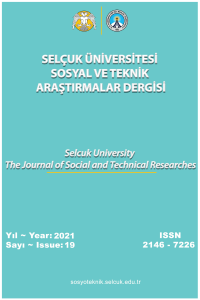USAGE OF INTERACTIVE TECHNOLOGIES IN TOURISM GUIDANCE EDUCATION
USAGE OF INTERACTIVE TECHNOLOGIES IN TOURISM GUIDANCE EDUCATION
Interactive Technologies Tour Guiding, Education, Attitude Scale,
___
- Dönmezoğlu, D. (2013). Günümüz Müzeciliğinde Sergileme Tekniklerinin Sanal Teknolojiler İle Desteklenmesi Ve Uygulama Örnekleri. Yayınlanmamış Uzmanlık Tezi, T.C. Kültür ve Turizm Bakanlığı Kültür Varlıkları Ve Müzeler Genel Müdürlüğü. Ankara.
- Hacioglu and Tekin, (2016). Impacts of Technological Applications to Service Quality of Professional Tour Guides (The Case of Ankara Anatolian Civilisation Museum). 2.International Eurasia Tourism Congress: 5-7 May 2015, Konya.
- Ham, S.H. (1992). “Environmental Interpretation: A Practical Guide for People with Big Ideas and Small Budgets” North American Press, 456.
- Kozak, M. (2015). Bilimsel Araştırma: Tasarım, Yazım ve Yayım Teknikleri, Detay Yayıncılık. Ankara.
- Tekin, Ö., Bideci, M. ve Aydın, A (2015). “Kültürel Mirasın Aktarımında Mobil Rehber Uygulamaları ile Profesyonel Turist Rehberlerinin Yetkinliğinin Karşılaştırması (Konya Mevlana Müzesi Örneği): International Eurasia Tourism Congress: 28-30 May 2015, Konya.
- Yavuz, S. (2005). Developing a technology attitude scale for pre-service chemistry teachers. The Turkish Online Journal of Educational Technology – TOJET, 4, 1, 17-25.
- Yildiz, R., Kusluvan, S. ve Senyurt, Y. (1997). A New Model on Tourist Guide Education. Weekend Workshop IV: Türkiye’de Turizmin Gelistirilmesinde Turist Rehberlerinin Rolu, (7-36) Erciyes University Nevsehir Tourism and Hotel Management School. Kayseri: Erciyes University Press.
- www.osym.gov.tr (07.12.2016)
- www.yok.gov.tr (06.12.2016)
- http://www.wftga.org/tourist-guiding/what-tourist-guide (30.11.2016)
- Başlangıç: 2011
- Yayıncı: Selçuk Üniversitesi
THE PERCEPTIONS OF THE CUSTOMERS STAYING AT HOTELS TOWARDS ONLINE SHOPPING
KAYIT DIŞI EKONOMİ:İLLEGAL BAHİS
KONYA MAVİ TÜNEL İÇME SUYU UYGULAMA PROJESİNİN ÇEVREYE OLAN ETKİLERİN DEĞERLENDİRİLMESİ
Naci BÜYÜKKARACIĞAN, Atila DEMİRÖZ, A. Hakim MOBAREZ
KURUMSAL İTİBARIN KAZANILMASINDA KURUMSAL SOSYAL SORUMLULUK BİLİNCİNİN VE ETİK YAKLAŞIMIN ROLÜ
USAGE OF INTERACTIVE TECHNOLOGIES IN TOURISM GUIDANCE EDUCATION
Ahmet BÜYÜKŞALVARCI, İsa ALTINIŞIK, Özlem TEKİN
TÜRKİYE’DE SURİYELİ GÖÇMENLERE YÖNELİK YAPILAN EĞİTİM ÇALIŞMALARI
Handan ERTAŞ, Fatma ÇİFTÇİ KIRAÇ
OTEL İŞLETMELERİNDE ENGELLİ OLANAKLARINA İLİŞKİN YÖNETİCİLERİN GÖRÜŞLERİ: KONYA ÖRNEĞİ
Ahmet BÜYÜKŞALVARCI, Mustafa Cüneyt ŞAPCILAR, Meltem TUNCEL
ENTROPİ TEMELLİ MAUT YÖNTEMİNE GÖRE DEVLET ÜNİVERSİTELERİ KÜTÜPHANELERİNİN DEĞERLENDİRİLMESİ
